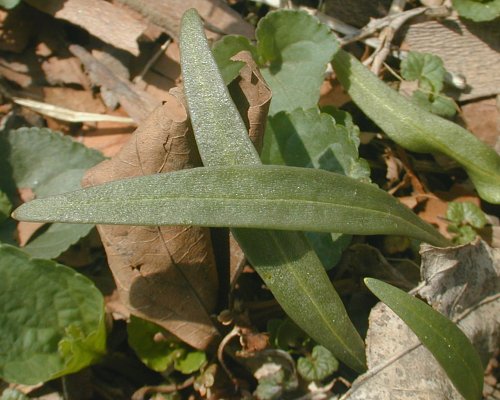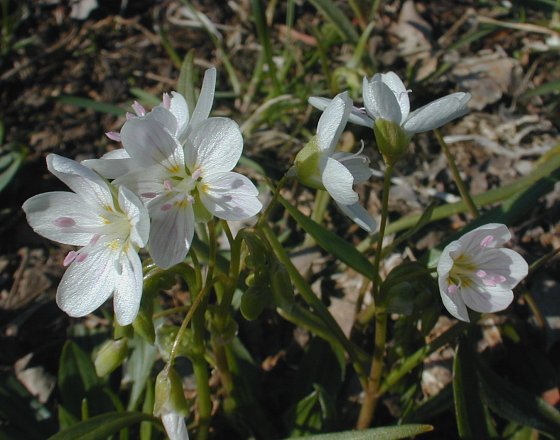Description: This perennial wildflower is about 3-6" tall, consisting of a flowering stem with a pair of opposite cauline leaves and some basal leaves. The stem is light green or slightly reddish green, glabrous, and rather succulent. The basal leaves and the pair of cauline leaves are linear or linear-lanceolate, slightly recurved, glabrous, smooth along the margins, and slightly fleshy. There is a single central vein along the length of each leaf. The leaves are about 2-5" long; their width varies somewhat depending on the local ecotype, but it is usually about ¼" across. The stem terminates in a floppy raceme of flowers. Each flower is about 8 mm. (1/3") across when it is fully open, consisting of 5 petals, 2 green sepals, 5 stamens with pink anthers, and a pistil with a tripartite style. The petals are white with fine pink stripes; these stripes vary from pale pink to bright pink. The flowers open up on warm sunny days, and close during cloudy weather or at night. They are more or less erect while open, but nod downward while closed. The blooming period occurs from mid- to late spring and lasts about 1-2 months. There is a pleasant floral scent. Each fertile flower produces an ovoid capsule containing several seeds; this capsule is enclosed by the 2 persistant sepals. The root system consists of a small corm and secondary roots. This wildflower spreads by reseeding itself; sometimes it forms rather loose colonies of plants.

Cultivation:
The preference is dappled sunlight during the spring, moist to slightly
dry conditions, and a rich loamy soil with abundant organic matter.
This wildflower will adapt to semi-shaded areas of lawns if mowing is
delayed during the spring. Both the flowers and foliage fade away by
mid-summer. The easy way to start plants is by obtaining
their corms, although these are expensive to buy from
nurseries.
Range & Habitat:
The native Spring Beauty is a common wildflower that occurs in every
county of Illinois (see Distribution
Map). Habitats include moist to dry deciduous woodlands,
savannas, thinly wooded bluffs, city parks, old cemeteries, and lawns
(particularly near trees). Less often, this species is found in mesic
prairies, but it is primarily a woodland plant. Spring Beauty can
survive more environmental degradation than most spring-blooming
woodland species, including occasional grazing by cattle and partial
clearing of trees. This is one reason why it is still common.

Faunal Association: Aside from insect pollination, little is known about floral-faunal relationships. Various kinds of bees visit the flowers, include honey bees, bumblebees, little carpenter bees (Ceratina spp.), mason bees (Osmia spp.), cuckoo bees (Nomada spp.), Halictid bees (Agapostemon spp., Augochlorella spp., Halictus spp., Lasioglossum spp.), and Andrenid bees (Andrena spp.). An Andrenid bee, Andrena erigeniae, is a specialist pollinator of Spring Beauty. Many flies also visit the flowers, including Syrphid flies, the Giant Bee fly (Bombylius major), flesh flies (Sarcophagidae), and Calliphorid flies. Less often, various butterflies and skippers visit the flowers. These insects usually seek nectar, although some of the bees also collect pollen. The corms of Spring Beauty are dug up and eaten by some small rodents, including the White-Footed Mouse and Eastern Chipmunk (Martin et al., 1951/1961; Wrazen & Svendsen, 1978). The foliage is browsed sparingly by White-Tailed Deer (Augustine, 1997). While the corms of Spring Beauty can be eaten by humans as well, their small size makes this rather impractical.

Photographic
Location:
Busey Woods and an old cemetery in Urbana, Illinois.
Comments:
This attractive wildflower is a sure sign that spring has arrived and
that the local woodlands are full of wildflowers. When Spring Beauty
and these other wildflowers are conspicuously absent from a woodlands,
this indicates that it has been subjected to severe degradation from
plows or bulldozers at some point in the past. In Illinois, Spring
Beauty is a unique member of the Purslane family that is easy to
distinguish from other wildflowers. Look for pink-stripes, whether pale
or bright, on the petals of the flowers, and only 2 sepals underneath.
In southeastern and other parts of the United States, there is a
closely related wildflower, Claytonia carolina
(Carolina Beauty). This latter species has a similar appearance to
Spring Beauty, but it doesn't occur in Illinois. The leaves of Carolina
Beauty are usually broader than those of Spring Beauty.